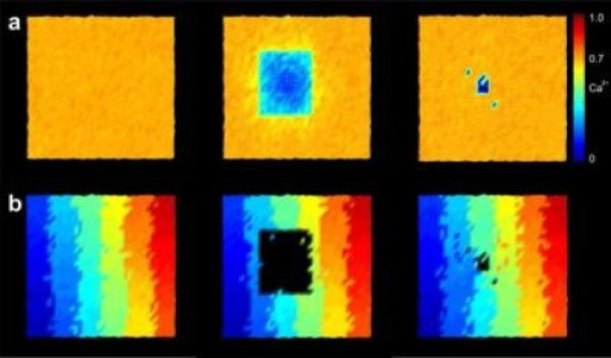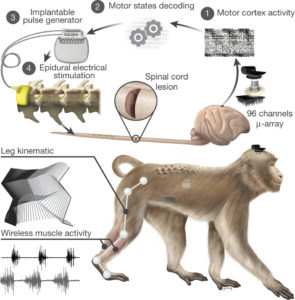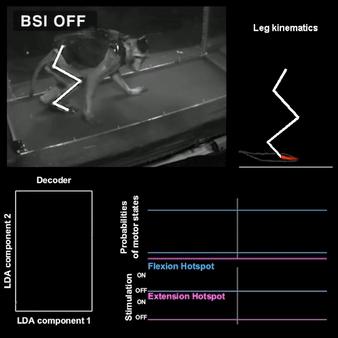A blog by Kirk Wydner — Bringing you the latest news at the crossroads of neuroscience and technology.
December 27th, 2016
Spinal cord injuries have always come with a painful finality. The delicate nature of our nervous system makes it very difficult if not impossible for any recovery to happen after a severe accident. That means that any action carried out by the damaged nerve — sensation of touch, pain, hot/cold, or motor control of a muscle — is partially or completed blocked off from then on. In the world of modern medicine that first-world countries like ours enjoy, where once-devastating diseases such as smallpox and polio have been all but eradicated, the lack of treatment options for a condition as debilitating as a spinal injury has become a major gap in medical progress.
[cue the dancing walking monkey]
A massive collaboration of research institutions across the globe (from Switzerland, USA, UK, Germany, China, Italy and France) has recently published a ground-breaking report in Nature magazine on restoring a monkey’s ability to walk after spinal cord injury. This miraculous feat (no pun intended) was accomplished through several key innovations. First, the researchers located and created a 3D-map of the regions of the spinal cord responsible for the movement of the monkey’s right hind leg. Next, they placed electrodes into those regions while the monkey still had control of the leg and recorded the intensity and timing of the nerves firing for later use. Then, although the ethics behind it is debatable (see my previous post), the team lesioned the portion of the monkey’s spine responsible for controlling that leg. Six days after the injury, they reattached electrodes to the spine and attached an electrode grid to the monkey’s “right leg” portion of the motor strip (or “motor cortex”) of its brain. The signals coming from the monkey’s brain were sent wirelessly to a computer for interpretation and then, using the nerve activity recording from before, converted into instructions sent wirelessly to the electrodes in the monkey’s spine allowing the monkey to regain control the muscles of its leg. The result (seen in the video below) is nothing short of amazing. The collaboration is already turning its sights to human proofs-of-concept. Who knows, in 20 years permanent spinal cord injuries could be another thing of the past.
Video Source: http://www.nature.com/nature/journal/v539/n7628/extref/nature20118-sv1.mp4
Article Source: http://www.nature.com/nature/journal/v539/n7628/full/nature20118.html
October 20th, 2016

Technology continues to enhance the way we study and understand the brain. For instance, the image above is a model generated by a supercomputer to show how the visual center of the brain recovers vision after the retina has been damaged. Simulating even a single neuron requires intense computing power, so simulating thousands takes a whole room full of the fastest computers on earth! The simulation that produced this particular model ran on the supercomputing grid at the Simulation Laboratory Neuroscience at the Jülich Supercomputing Centre in northwestern Germany (see video below). The images in the B column show the information getting sent to the visual center from the retina before damage (left image), immediately after damage (center image), and after a period of growth and recovery (right image). The images in the A column show the areas affected by the damage. What’s taking place here is a highly complex reorganization of information. The neighboring neurons in the visual center begin to build new connections to the neurons affected by retinal damage. They “fill in the gaps” in information like they do for your blind spot (read more here).
It would be unethical to perform intentional damage to the retina of a living creature just for the sake of experimentation, as early neuroscience research used to do. Computer simulated models such as this one can provide us with the same level of insight into the restorative mechanisms of the brain without harming live subjects. We can use this information to help us develop better rehabilitative treatment for patients who have experienced amputation, brain injury, neurodegenerative diseases, strokes, or any number of nerve-related injuries. And as our computing power gets better and better every year, we will be able to simulate more and more complex maladies and treatment options. Just one more way that technology and the advancement of neuroscience are intimately linked.
Video source: http://www.fz-juelich.de/ias/jsc/EN/Expertise/SimLab/slns/media/media_node.html
Article source: https://www.sciencedaily.com/releases/2013/10/131010205325.htm




